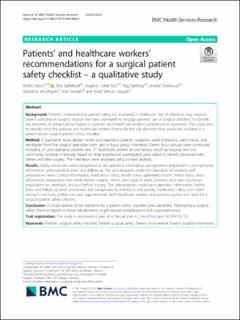Patients’ and healthcare workers’ recommendations for a surgical patient safety checklist – a qualitative study
Harris, Kristin; Softeland, Eirik; Moi, Asgjerd Litleré; Harthug, Stig; Storesund, Anette; Jesuthasan, Sebastius; Sevdalis, Nick; Haugen, Arvid Steinar
Journal article, Peer reviewed
Published version

Åpne
Permanent lenke
https://hdl.handle.net/11250/2732280Utgivelsesdato
2020Metadata
Vis full innførselSamlinger
- Department of Clinical Medicine [2065]
- Registrations from Cristin [9766]
Originalversjon
BMC Health Services Research. 2020, 20, 43. https://doi.org/10.1186/s12913-020-4888-1Sammendrag
Background: Patients’ involvement in patient safety has increased in healthcare. Use of checklists may improve patient outcome in surgery, though few have attempted to engage patients’ use of surgical checklist. To identify risk elements of complications based on patients’ and healthcare workers’ experiences is warranted. This study aims to identify what the patients and healthcare workers find to be the risk elements that should be included in a patient-driven surgical patient safety checklist.
Method: A qualitative study design where post-operative patients, surgeons, ward physicians, ward nurses, and secretaries from five surgical specialties took part in focus group interviews. Eleven focus groups were conducted including 25 post-operative patients and 27 healthcare workers at one tertiary teaching hospital and one community hospital in Norway. Based on their experiences, participants were asked to identify perceived risks before and after surgery. The interviews were analysed using content analysis.
Results: Safety risk factors were categorised as pre-operative information: pre-operative preparations, post-operative information, post-operative plans and follow-up. The subcategories under pre-operative information and preparations were: contact information, medication safety, health status, optimising health, dental status, read information, preparation two weeks before surgery, inform your surgical ward, planning your own discharge, preparation on admission and just before surgery. The subcategories under post-operative information, further plans and follow-up were: prevention and complications, restriction and activity, medication safety, pain relief, stomach functions, further care and appointments. Both healthcare workers and patients express the need for a surgical patient safety checklist.
Conclusion: A broad spectre of risk elements for a patient safety checklist were identified. Developing a surgical safety checklist based on these risk elements might reduce complications and unwanted errors.
